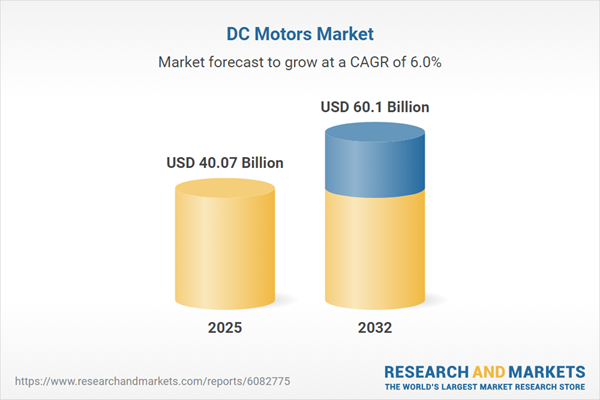Speak directly to the analyst to clarify any post sales queries you may have.
The direct current (DC) motors market is undergoing substantial change as innovation, regulatory developments, and application demand reshape competitive priorities. Senior leaders are refining operational models and technology investments to deliver reliable and efficient motion solutions amid evolving global business conditions.
Market Snapshot: Direct Current Motors Market Overview
The DC motors market demonstrates robust momentum, with a market expansion from USD 37.76 billion in 2024 to USD 40.07 billion in 2025 and a forecasted reach to USD 60.10 billion by 2032. This trajectory signals a compound annual growth rate (CAGR) of 5.98%, indicative of strong and sustained demand arising from automation initiatives, transportation electrification, and progress in renewable energy sectors. Continued advances in materials science and power electronics foster product differentiation and value creation. Key stakeholders such as original equipment manufacturers, component suppliers, and end users increasingly require solutions that blend dependability, efficiency, and compliance with a complex regulatory setting.
Scope & Segmentation of the Direct Current Motors Market
- Product Types: Brushed DC motors, including permanent magnet and wound field versions, alongside brushless types—such as inner rotor and outer rotor models—serve a spectrum of operational needs. Brushed variants offer simplicity and cost-effectiveness, while brushless motors deliver improved longevity, control, and maintenance benefits.
- End Use Industries: Sectors like aerospace and defense, automotive, consumer appliances, industrial, and medical equipment deploy DC motors to fulfill specific requirements for safety, reliability, and operational performance.
- Power Ratings: Fractional horsepower models target lightweight and compact applications, whereas integral horsepower options support demanding industrial and vehicular roles, enhancing system versatility.
- Voltage Ratings: High voltage, medium voltage, and low voltage solutions cater to varied power system infrastructures, permitting adaptation to a broad range of industry and project scales.
- Mounting Types: Face mount, flange, and foot mount options provide flexibility in both new equipment integration and retrofitting, enabling optimized assembly and maintenance accessibility.
- Distribution Channels: Aftermarket offerings augment original equipment manufacturer supply chains, enabling consistent parts availability for both new installations and ongoing asset management.
- Regional Markets: The Americas, Europe, Middle East & Africa, and Asia-Pacific represent pivotal markets, each shaped by unique regulatory protocols, manufacturing capabilities, and adoption timelines for emerging technologies.
- Notable Companies: Leading market participants include Nidec Corporation, Johnson Electric Holdings Limited, Mabuchi Motor Co., Ltd., Bosch Rexroth AG, Maxon Motor AG, MinebeaMitsumi Inc., TECO Electric & Machinery Co., Ltd., Dr. Fritz Faulhaber GmbH & Co. KG, Oriental Motor Co., Ltd., and Allied Motion Technologies, Inc.—each driving strategic competition and sector innovation.
Key Takeaways: Strategic Insights for Senior Decision-Makers
- Adoption of brushless DC motors is growing, supporting operational reliability, lifecycle efficiency, and reduced maintenance requirements across major industry segments.
- Customization is increasing, with industries seeking tailored features: consumer appliances emphasize reduced noise, automotive focuses on agility, and medical sectors prioritize compliance—highlighting the market’s shift toward adaptable and modular solutions.
- Regional regulatory frameworks are shaping procurement, spurring focus on recyclable materials and energy efficiency to support circular economy goals and meet rising standards in environmental responsibility.
- Digital monitoring and predictive analytics are enabling organizations to maximize equipment uptime, leverage service-based revenue models, and execute predictive maintenance more effectively.
- Shifts in global trade conditions and the evolving supply chain, including adaptation to tariffs and geopolitical developments, are prompting companies to reevaluate sourcing models to maintain agility and protect profit margins.
Tariff Impact: Navigating the 2025 United States Tariffs
The imposition of new United States tariffs on imported DC motors in 2025 is leading many global suppliers to reassess and adapt their sourcing and manufacturing strategies. Firms are relocating facilities, forging regional partnerships, and redesigning supply chains to preserve market access and competitiveness. This evolving scenario is increasing the need for nimble logistics, greater investment in efficient motor technologies, and supplier diversification in order to manage cost volatility and maintain profitability.
Methodology & Data Sources
This analysis employs a rigorous research methodology combining technical literature reviews, regulatory analysis, in-depth executive interviews, and industry surveys. All quantitative market data is verified across multiple independent sources and modeled to reveal key drivers and trends affecting each region and market segment. This approach ensures an objective and comprehensive perspective.
Why This Report Matters
- Empowers executive teams to anticipate market developments, align procurement decisions, and adapt technology strategies for enhanced resilience and operational excellence.
- Delivers actionable insights into trade shifts, regulatory trends, and industry digitalization, allowing for informed risk mitigation and growth planning throughout the DC motors supply chain.
- Supports product development and sourcing strategies that address evolving market needs, reinforcing long-term competitive positioning.
Conclusion
Innovation, regulatory compliance, and responsive supply chain strategies are central to success in today’s DC motors market. Senior leaders who embrace digital integration, sustainability objectives, and collaborative partnerships will be well-positioned to secure future opportunities and address new challenges with confidence.
Table of Contents
3. Executive Summary
4. Market Overview
7. Cumulative Impact of Artificial Intelligence 2025
Companies Mentioned
The companies profiled in this DC Motors market report include:- Nidec Corporation
- Johnson Electric Holdings Limited
- Mabuchi Motor Co., Ltd.
- Bosch Rexroth AG
- Maxon Motor AG
- MinebeaMitsumi Inc.
- TECO Electric & Machinery Co., Ltd.
- Dr. Fritz Faulhaber GmbH & Co. KG
- Oriental Motor Co., Ltd.
- Allied Motion Technologies, Inc.
Table Information
| Report Attribute | Details |
|---|---|
| No. of Pages | 184 |
| Published | October 2025 |
| Forecast Period | 2025 - 2032 |
| Estimated Market Value ( USD | $ 40.07 Billion |
| Forecasted Market Value ( USD | $ 60.1 Billion |
| Compound Annual Growth Rate | 5.9% |
| Regions Covered | Global |
| No. of Companies Mentioned | 11 |









